This is part of a series of articles on activation and making sure users experience and appreciate your product’s value.
In this article, we will discuss what is the “aha moment” and the conditions necessary to achieve it. We will also talk about why “aha moment” and the path to it should differ depending on the problem the user is trying to solve.
→ Test your product management and data skills with this free Growth Skills Assessment Test.
→ Learn data-driven product management in Simulator by GoPractice.
→ Learn growth and realize the maximum potential of your product in Product Growth Simulator.
→ Learn to apply generative AI to create products and automate processes in Generative AI for Product Managers – Mini Simulator.
→ Learn AI/ML through practice by completing four projects around the most common AI problems in AI/ML Simulator for Product Managers.
All posts from the series
01. When user activation matters and you should focus on it.
02. User activation is one of the key levers for product growth.
03. The dos and don’ts of measuring activation.
04. How “aha moment” and the path to it change depending on the use case.
05. How to find “aha moment”: a qualitative plus quantitative approach.
06. How to determine the conditions necessary for the “aha moment”.
07. Time to value: an important lever for user activation growth.
08. How time to value and product complexity shape user activation.
09. Product-level building blocks for designing activation.
10. When and why to add people to the user activation process.
11. Session analysis: an important tool for designing activation.
12. CJM: from first encounter to the “aha moment”.
13. Designing activation in reverse: value first, acquisition channels last.
14. User activation starts long before sign-up.
15. Value windows: finding when users are ready to benefit from your product.
16. Why objective vs. perceived product value matters for activation.
17. Testing user activation fit for diverse use cases.
18. When to invest in optimizing user onboarding and activation.
19. Optimize user activation by reducing friction and strengthening motivation.
20. Reducing friction, strengthening user motivation: onboarding scenarios and solutions.
21. How to improve user activation by obtaining and leveraging additional user data.
Onboarding and activation bridge the gap between the objective value of the product and the subjective experience of the user. In other words, they help users understand why they should choose your product instead of other solutions they know.
In the previous article, we found out that to measure the effectiveness of activation, you need to use retention in the target action, or the amount of “job” that the product fulfills for a cohort of users. This approach allows you to measure how many users have realized the benefits of the product and made it part of their lives.
But we also want to understand on a deeper level how users are affected by product changes, and around which key actions the first session and onboarding should be built.
To answer this question, we have to study a successful user who has realized the value of the product, and retrace their steps from success backwards.
Key Steps to User Success
A successful user is someone who is regularly using your product (and not the alternatives) to solve problems in their life. The more “job” a product fulfills for the user, the better.
To enter this state, the new user must experience an “aha moment.” This is the moment the user first feels the added value of the product and realizes the benefits of having in their life.
For the user to reach “aha moment” and experience the value usually different conditions must be met. Understanding these prerequisites is critical for building an effective activation process.
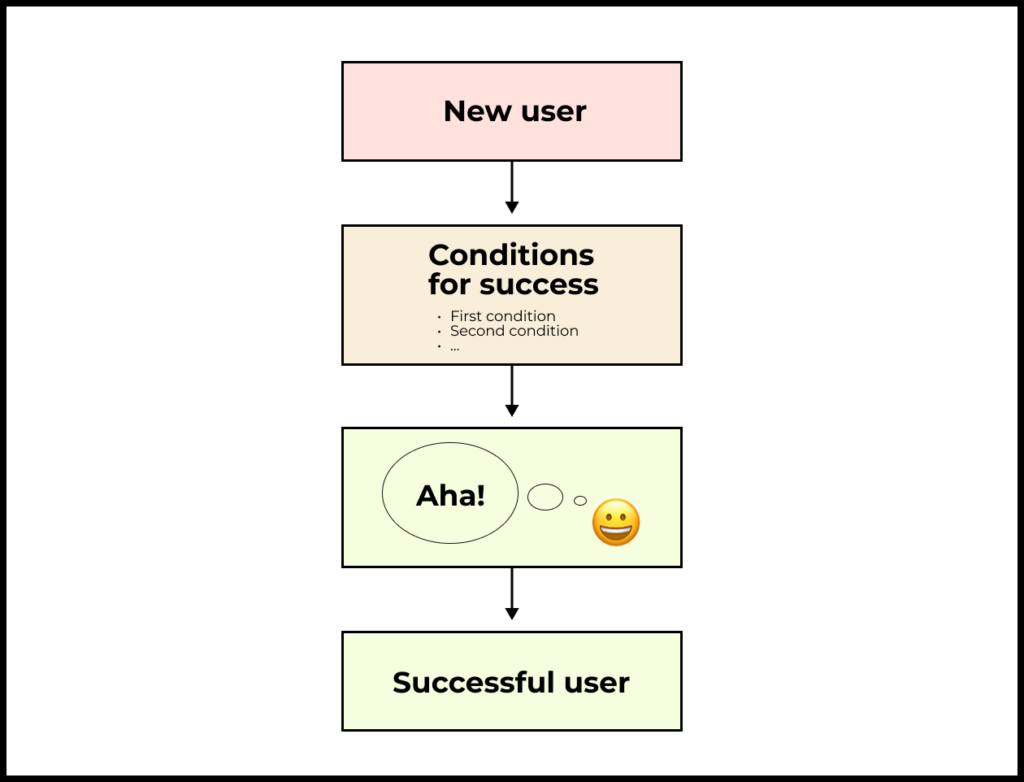
Examples of user activation paths in different products
Activation in dating apps
Let’s consider user activation in a dating application.
A successful user is one who tried the application, and after a while began to choose it to find a date partner.
To do this, the user must experience the added value of the product, i.e., they must feel rewarded for the time invested in the service shortly after registration. This reward must either be significantly better than alternative products, or at least increase the overall efficiency of solving the problem to makes sense for the user to use several solutions at the same time (for example, installing and using an extra dating app might be more effective than using just one).
A potential example of an “aha moment” would be to arrange a date within two days of registering. Another example could be a high-quality and exciting chat with another user during the day after registration. Such target events will allow users to feel the progress in solving the problem.
The necessary conditions to achieve the “aha moment”:
- First, the user must upload a photo and fill out a profile. The probability of receiving an answer without a photo or a full profile tends to zero.
- Second, the user must find and like several other profiles. To do this, the application must have other people from the user’s city.
- Third, the user must receive at least one like back. This is required to start a chat. Achieving the “aha moment” without meeting these conditions is impossible.
Activation in fast food delivery
Consider user activation in a 15-minute food delivery service.
A successful user is one who tried the service and began using it regularly to order food. The user’s level of success is proportionate to the share of their food budget they are spending on the service (in comparison to alternatives).
A potential “aha moment” could be the successful delivery of the first order within the advertised time. Many users realize at this moment that ordering products in the application is much more convenient and easier than going to the store. This is especially true if the user is already in the middle of cooking something or if the weather is extremely unpleasant.
The necessary conditions to achieve the “aha moment”:
- First, the user must be in the service area.
- Second, the range of available products should cover the user’s task.
- Third, the user must successfully connect and use one of the available payment methods.
- Fourth, the courier must deliver the assembled package within the promised time.
Definitions of success and “aha moment” depend on the user’s task
Please note that above we specified the exact use case for each of the products. We talked about the exact task with which the user came to the corresponding service.
In reality, a product can solve different problems. For users with different tasks, the added value will differ. Accordingly, the definitions of success and “aha moment” and their required conditions will differ by use case.
Miro Collaboration Tool
Consider the popular collaboration service Miro.
One of the use cases in Miro is to organize ideas and compile a mindmap. It is a “single-player” use case where the user needs tools to visualize ideas and link them together.
Another use case in Miro is team brainstorming. In this case, the entire team must be registered with Miro to experience its value. The team needs real-time collaboration tools and special features to organize a brainstorm session.
For each of these use cases, the value of the product will be different, as will be the “aha moment”, the necessary conditions for its achievement, and the optimal path to the target experience.
Workplace Communication Service
Consider Workplace, a product by Meta for communication within organizations.
One of the challenges of Workplace is that different companies have different needs, and thus find different value in it.
For a small restaurant, Workplace can solve urgent problems: distributing shifts between waiters, managing food stocks, building a knowledge base, discussing current affairs, and announcing important news.
But for a large international restaurant chain, Workplace creates value in a completely different way: building horizontal connections between tens of thousands of employees, creating a secure and safe space to discuss work issues, providing a directory to find the right people in the organization, increasing the efficiency of broadcasting information, bridging the gap between employees and management.
Delivering the value of the product to each of these organizations will require completely different mechanisms. For each of these organizations, the moment of realizing the product’s value and the path to it will be radically different.
Different activation mechanisms for different use cases
Many products have achieved product/market fit for different purposes and different user segments.
On the one hand, this is good, as it allows the product to create more value, providing more growth opportunities for the team.
On the other hand, it complicates product management. The emergence of different use cases increases the likelihood of conflicts at different levels: target audience, team priorities, positioning.
For example, at some point, Facebook grew to such a scale that almost all Internet users created accounts on the social network. Theoretically, at this point, network effects should have provided maximum value to the users of the service. But it created complications. For example, young users didn’t want to openly communicate and express themselves on a platform where their parents were, which is why many left Facebook for Snapchat and other services. Other users were not comfortable posting their thoughts or photos on a site where their colleagues or bosses were.
Similar conflicts also affect user activation mechanisms. For different use cases, the added value and the “aha moment” and the necessary conditions for its achievement differ significantly. The team must build different mechanisms for delivering value for each use case, and form separate metrics to measure their effectiveness. That is why when discussing “aha moment” and activation, in general, it is always important to specify which use case we are talking about.
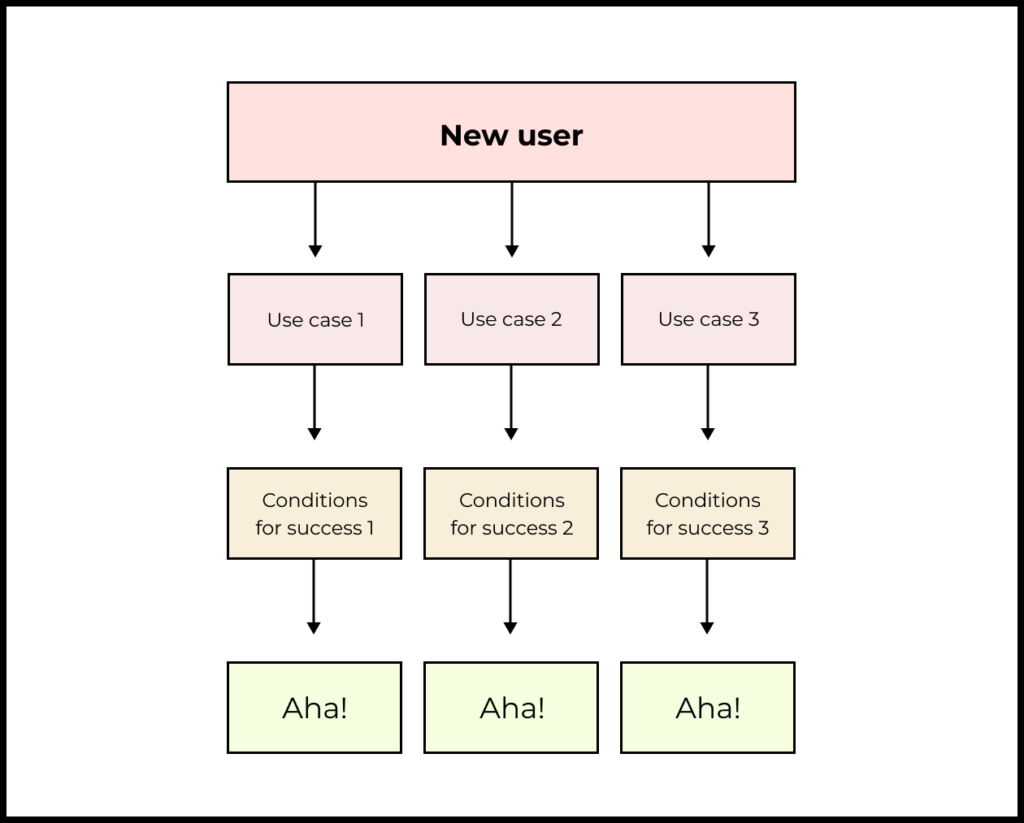
Activation design for a product with a variety of use cases
In a simple product with a single use case, all users will follow a similar path to experiencing its value. In a situation where a product solves several different tasks at once, the activation design becomes much more complicated.
Below we will discuss different approaches for building value delivery mechanisms for a product with a variety of use cases.
Adding people to the activation process
Conveying the value of complex products solely through automated product flows may be impossible: there are too many nuances and subtleties, making it necessary to use a manual approach. In this case, the problem can be solved by adding people to the activation process.
In very complex and expensive products, dedicated teams can be allocated to different clients. These teams analyze the client’s needs, make test pilots, help adapt the product to these needs, and train the client’s employees. Sometimes this function is performed by integrators and resellers who take an off-the-shelf product and optimize it for the needs of the client.
In medium-complexity B2B products, sales managers or customer success specialists can be assigned to identify the needs of a particular customer and communicate the value of the product.
Adding people to the activation process can also be encountered in B2C products, though less often. For example, before using the Superhuman email client, users had to schedule a call with a company representative who took them through the onboarding process. The purpose of this mechanism was to exclude irrelevant users and explain to relevant users how exactly Superhuman can make their lives better.

Building separate products for different use cases
In some cases, companies spin off separate sub-products that target different user segments and use cases.
The Workplace team eventually split in two. One worked on a product for enterprise clients, and the other worked on a product for small and medium organizations. These segments had tasks that were so different that they required different features and could not be brought together in a single product.
An example from the B2C world: Facebook spun off Messenger as a separate mobile app because having both chat and social networking in one product reduced the effectiveness of each.
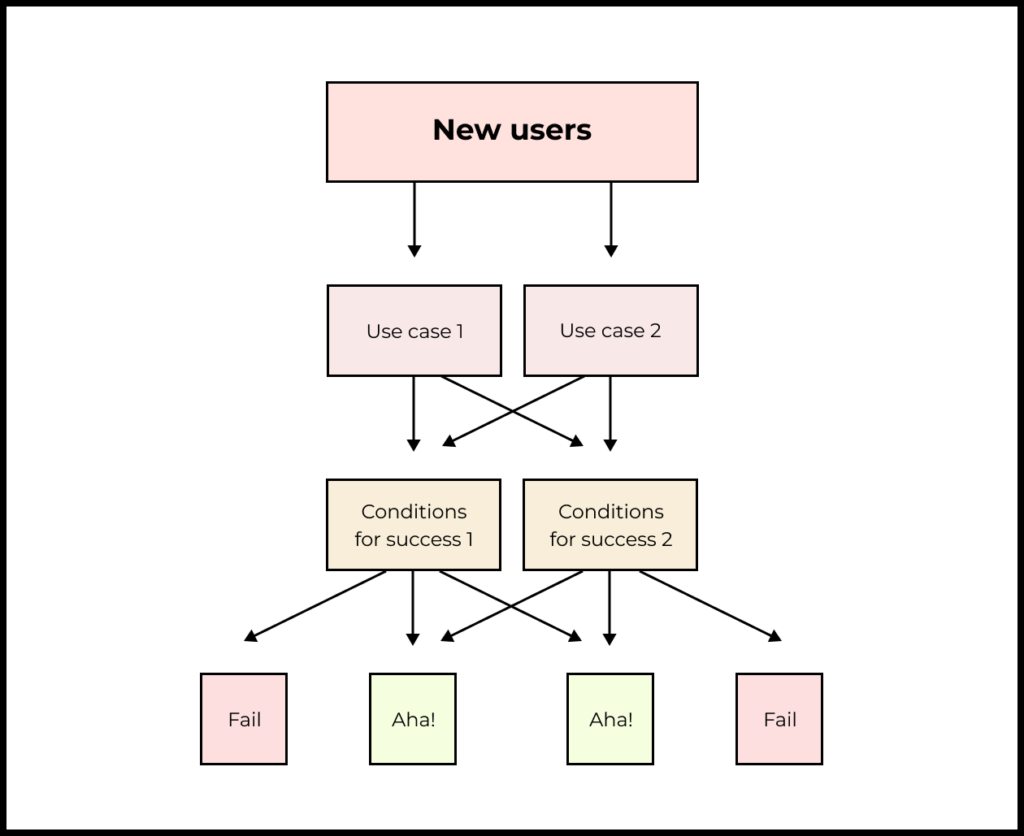
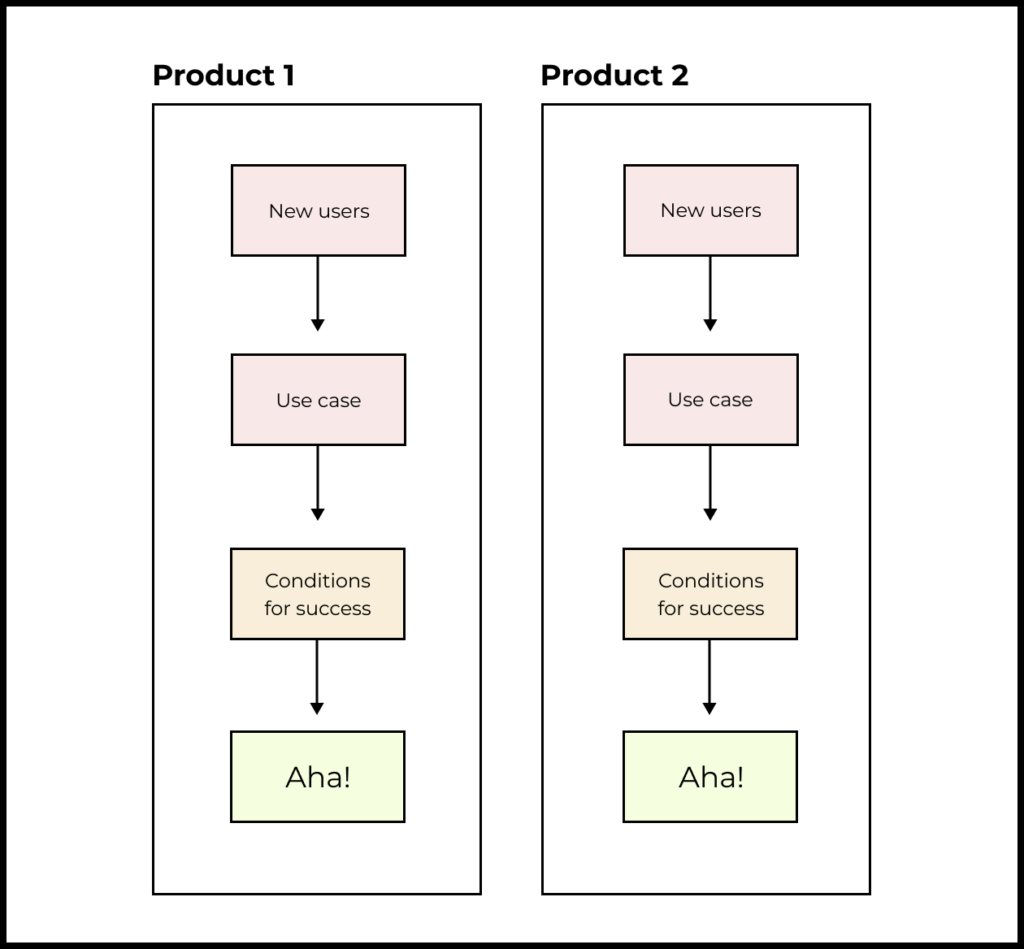
Sending users into different activation flows based on additional information about the user
In some cases, additional information about the user can help to accurately identify the target use case. This can be a traffic source, a registration landing page, information that a user fills out during registration, or data provided by third-party services. In a previous essay, we discussed the Dropbox example, where the target use case can often be identified based on how the user arrived at the product.
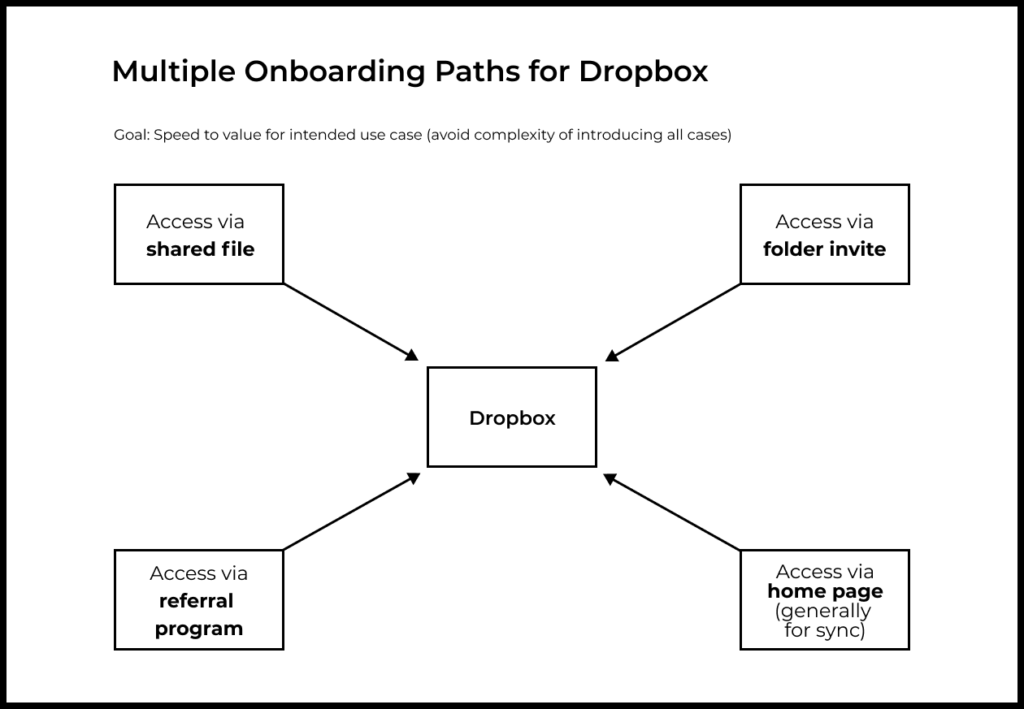
Here are a few more examples:
After acquiring users through paid ads, e-commerce platforms try to guide them to the catalog page of the product they are looking for. If users come from search, their query highlights their and can in adapting the future activation process.
B2B products use the domain of the user’s work email to either add it to the account of an organization that already exists on the service, or to send it along the flow of creating a new one. The domain also provides an opportunity to enrich available information about the company from various third-party services that provide data on company size, industry, and other important parameters.
Another common approach is to customize the user experience based on information collected during onboarding. For example, Twitter asks users to select interests as part of their onboarding process. It then uses that information to help them find people to follow.
Sequential activation in different use cases
Some products solve many tasks for users. But users often start using the product for one or two main tasks, and later adopt other use cases.
In this case, data analysis can help identify key activation sequences through which users master the product. After that, you will need to build your product activation process around the key use cases in which users begin to interact with the product. The goal is to turn new users into regular ones, so that they can later learn and master other product features.
For Revolut, the key use case in the beginning was the ability to exchange currency without extra fees. Most early adopters came for this use case, and the team initially optimized the product to deliver this value. After that, the team began to add other use cases: trading, cryptocurrencies, savings accounts, and much more.
One popular apartment cleaning service activates many users through the window cleaning service. They deliberately sell this service at a low cost, which motivates users to try the service, link their credit/debit card, and share their address and phone number. The team uses this foundation to later communicate other product features to the users.
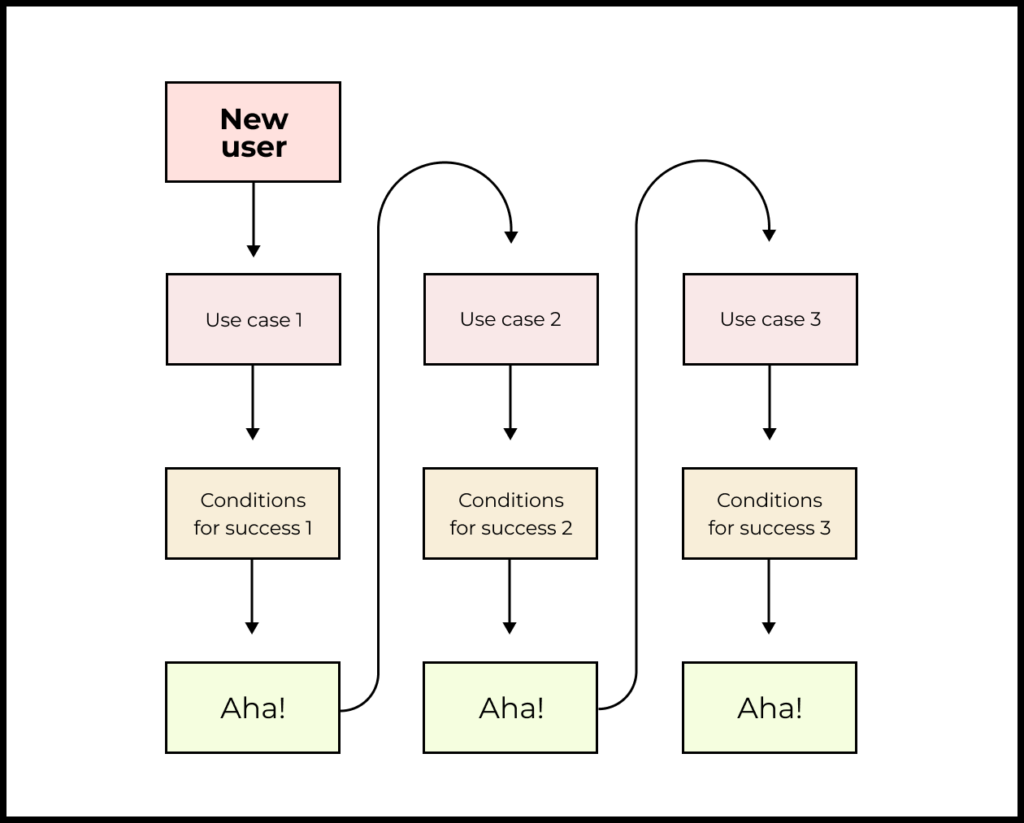
Activation can’t solve conflicting use cases
Siri is an example of a product with many different use cases.
People use Siri to find routes, set timers, find recipes, control music play while doing exercise, test AI abilities in a party, open apps on the phone, read emails, etc.
What makes this complicated is that it is almost impossible to guess the use case in advance. This makes it almost impossible to design the perfect user activation process. It is not clear what exactly new users want to do and how to guide them in the product to solve the problem.
Having multiple conflicting use cases or not having an optimal way of introducing users to the product value makes it very difficult to work on activation. But in this case, the root of the problem is not activation, but product design. It is at this level that it must be solved.
“Aha moment” and the path to it will differ by use case
User activation mechanisms should correspond directly to the task with which the user came to the product.
If the user wants to solve problem A, then it is pointless to lead him to the “aha moment” for solving problem B and demonstrate the product’s added value for this use case.
Therefore, when discussing work on activation, we will always talk about activation within a specific use case. If your product has several use cases, then you must think about how to properly identify a user’s use case: creating several products, building a design for sequential activation in different tasks, adding people to the process, using additional information about the user, etc.






